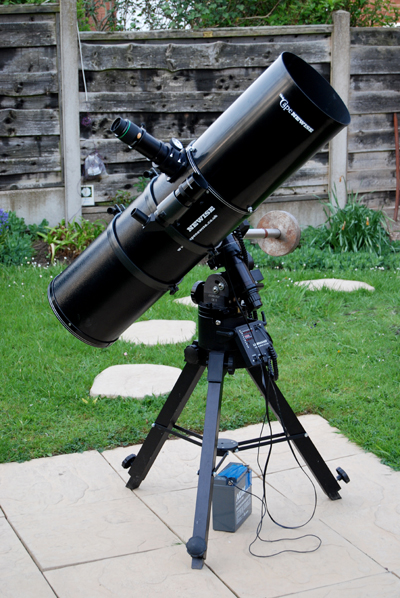30mm 80 degree apparent field 2” eyepiece
11mm 80 degree apparent field 1.25” eyepiece
Adaptor for mounting an SLR camera.
Custom Dew shield
Allen Key for collimation.
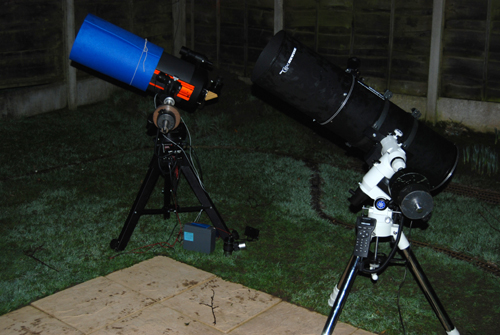
Comparison testing: the CapeNewise 200X and Celestron 9.25" Schmidt-Cassegrain
200x on Meade LXD 75 mount with Celestron 9.25" on Losmandy mount - you can see evidence of the dew (close to freezing) on the Newise dewshield. It did not dew up whilst the Celestron did.
Image: Ian Morison
Optical testing
This was done in three ways: by comparison observations with telescopes of known quality, star testing with stars and a Geoptic Artificial star and by the use of a “Ronchi” Grating.
Star testing
The Newise was used to observe both a "Geoptic" artificial star and a stars at high elevation on nights of good seeing. Star testing is a fairly vicious test and virtually no telescopes survive unscathed. The Newise held up very well indeed. No obvious astigmatism and just a little under correction for spherical abberation. None of my reflectors (including an excellent Newtonian better than 1/6 wave) gives a significantly better star test. I do have one apochromat refractor that does - but so it should considering its cost! It is just what one would expect from a good amateur telescope.
Ronchi Test
Observing an out of focus star through a finely lined "Ronchi" grating is known as the Ronchi Test. It is not as sensitive as the star test - perhaps a good thing - but can show if a lens or mirror is significantly over or under corrected and - where it works quite well - if there are regions of the lens or mirror, called zones, that do not conform to the overall shape. If all is perfect, one should see a set of parallel straight lines. If they are bowed one way or the other the optic will be either over or under corrected and, if they wiggle, the surface is not of a uniform shape and has zonal errors. The lines were smooth (which indicate smoothly polished lens surfaces), and there were no obvious wiggles in the parallel lines (so no significant spherical abberation or obvious zonal errors). Good.
Mounting
The telescope's tube rings are fitted to a high quality standard "Vixen Type" dovetail so I could immediately mount it onto a Meade LDX75 computerised mount which proved quite adequate for both visual and photographic use. It does, perhaps, deserve an even better mount, so an adaptor was made so that it could be fitted onto a Losmandy G8 mount controlled with an Argo Navis computer. Images above show it on both the Meade and Losmandy equatorial mounts. I have to say that the Losmandy combination really looks rather nice and received some complimentary comments at a "star party".
Wide field visual observations
The Newise comes with one of the 30mm, 80 degree wide field of view, eyepieces now available for the order of £60 or so. It has a field stop diameter of 45mm corresponding to an actual field of view of 2.0 degrees and gives a magnification of x 40. Such 80 degree apparent field eyepieces are called ultra-wide. I was really quite impressed with this eyepiece – it had better contrast (blacks were blacker) when viewing the Orion nebula than a similar and well rated eyepiece of mine with a similar specification, whilst the star images at the centre of the field of view were really excellent. The image quality did, as expected, fall off near the edge of the field of view. This is nothing to do with the telescope but the eyepiece. The only 30mm ultra wide angle eyepieces that can give pin-sharp stellar images to the edge of an 80 degree field are the Televue Nagler’s or equivalent costing upwards of £400, and you are not going to get one of those bundled with your telescope!!
I do, however, have two eyepieces that can give pin-sharp star images to the edge of the largest field that a 2” eyepiece can give. The first is a ~70mm eyepiece derived from a Meade Super Plossl that I acquired with one lens missing (I have no idea why!). With an apparent field of view of ~ 30 degrees it is rather like looking down a tunnel BUT it does provide edge to edge pin-sharp images and it did show a beautiful star field when observing the Pleiades Cluster with the Newise. At Astrofest 2007 I was able to purchase a new design of wide-field eyepiece having a 69 degree apparent field of view. It is a 40mm TMB Paragon sold by Burgess Optical. This gave an absolutely stunning view of the Pleiades indicating that the Newise does, indeed, have a wide well corrected field of view. Perhaps surprisingly, such a test cannot prove that the field is flat. As virtually all telescopes have curved field of views, optical designers often, as in the case of Thomas Beck who designed the Paragon, assume that there will be some field curvature and so include some correction. Bill Burgess of Burgess Optical who market the design was very interested to know how it would perform with a telescope having an inherently flat field. No problems!
Wide Field Photographic Observations
The Newise came with an adapter to enable a camera (given a suitable T-mount costing ~ £10) to be mounted with its film or CCD frame in the image plane. As – certainly in the case of the CCD, but not necessarily so in the case of a film camera – the detector surface is flat so the best test of a flat field is to produce star fields that have nice circular, pin point, images across the whole field. Sadly, I do not have a full frame digital camera which has a diagonal of 42mm (or 2 degrees on the sky with the Newise) but I do have a 10 Mpixel Nikon B80 with an APS-C sensor having a diagonal of 27mm (or 1.3 degrees of the sky). I used this to image both the Pleiades Cluster and the Sword of Orion. I quickly found that from my back garden in a town I could take no longer than a 30 second exposure without the light pollution fogging the image. I am thus not particularly proud of the two images shown below but here they are anyway. The stars of the trapezium show up quite well and are almost resolved in what is effectivly a very low power magnification image.
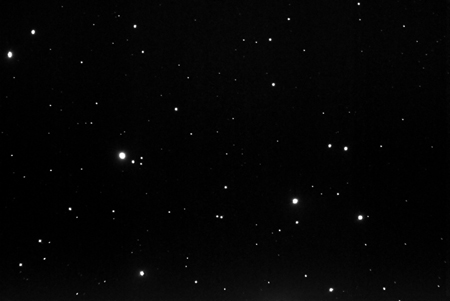
The Pleiades Cluster, M45
Nikon D80 on Newise 200X - Magnitude limited by light pollution!
Image: Ian Morison
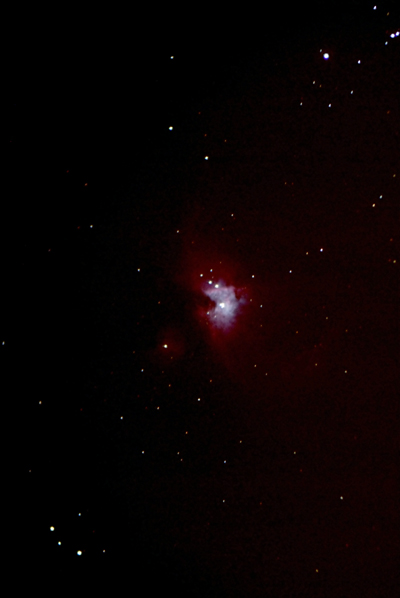
The Orion Nebula region
Nikon D80 on Newise 200X - light pollution limited
Image: Ian Morison
Medium Field Observations
The Newise came supplied with an 11mm 80 degree apparent field of view eyepiece. This is a “generic” Chinese made optic which can be bought for the order of £50 from a number of suppliers and, with the Newise, gives a magnification of 109 and an actual field of view of 0.71 degrees. I have no direct eyepiece to compare it with and the only close competitor would be a Televue 11mm Nagler costing several hundred pounds. It actually performed very well. The performance falls off beyond ~ 85% of the field which is entirely as expected when used with an f6 focal ratio telescope. The “trapezium” area of the Orion nebula looked very nice and comparable, but with a much wider field, to my 12.5mm Celestron Ultima and Vixen Lanthanum 10mm eyepieces (both excellent) which straddle its focal length.
There is a good reason for using wider field eyepieces than the standard Plossl designs apart from the so called “spacewalk” effect. For a given field size, such as that to encompass a globular cluster, a shorter focal length can be used which results in a higher magnification. The higher magnification reduces the apparent sky background without affecting the brightness of the stars, so fainter stars can be seen.
There were two issues with the 11mm eyepiece, both easily rectified. The first is that the eye relief is quite small and, as a result, the pupil of the eye has to be quite close to the eye-lens of the eyepiece. The (rather too hard) rubber eye cap makes it impossible to get the eye close enough. The remedy is simple – just remove it. The eyepiece then fits snugly into the eye recess and the full field can be seen at once. The interior of the barrel that fits into the focuser is very nicely ribbed and blackened (as it should be) but there is a metal coupling section which attaches the barrel into the body of the eyepiece. This has a shiny surface on its interior. This would reduce the contrast of the image when observing the Moon but not on most other objects. Again the solution is simple. It is very easy to remove this by first unscrewing the barrel from the eyepiece and then unscrewing the coupler. One can then paint the interior with a good matt black paint – I used “blackboard” paint. With a generous application one can even give the paint a fine “ribbed” surface. Problem solved.
I also used two excellent eyepieces to give somewhat higher powers; a Burgess optical 9mm “planetary” eyepiece and a Takahashi 7.5mm LE. The supplied 11 mm eyepiece was also used with an x2 Barlow lens to give the effect of 5.5mm eyepiece.
Saturn
One of the images above shows the Newise set up alongside a 9.25" Celestron Schmidt Cassegrain. It has a different optical design to most other such telescopes and is a very good performer. On a cold and dewy night, but with good seeing, I compared the images of Saturn as observed with the two scopes. There was very little in it. As a result of the larger aperture one of Saturn's fainter moons was more easily visible in the Celestron than in the Newise, but otherwise the images were very comparable. The Newise has a slightly "warmer" colour rendition than the Celestron which one would only notice by switching quickly from on the the other. I would like to point out to amateurs moving up from a smaller to a larger telescope, that, quite often, the view through the larger may appear worse than in the smaller. This is due to the scale size of the irregularities in the atmosphere and smaller scopes are less limited by the seeing than larger ones. Often a smaller scope will give a better image of a planet like Saturn, but under nights of good seeing the larger telescope will come into its own and give greater resolution. A colleague recently moved up from a 5" to an 8" telescope and, for a while, was somewhat dissapointed. Following a couple of nights of good seeing he isn't any longer!
Digital Imaging of the Moon
I am much happier with these images of the Moon! If using a digital SLR with the ~24mm x ~15mm sized CCD sensor, then the focal length is just right to sit the Moon nicely in the frame with a bit to spare. These images were taken in February, March and April 2007 - and included the night of the total eclipse of the Moon!
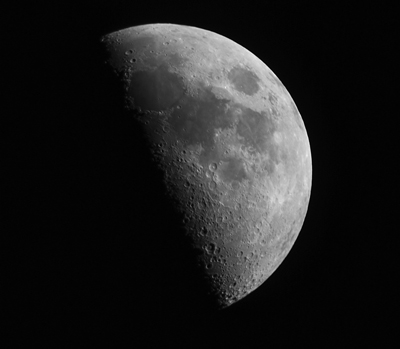
Moon 25th February 2007
Nikon D80 on Newise 200X
Image: Ian Morison
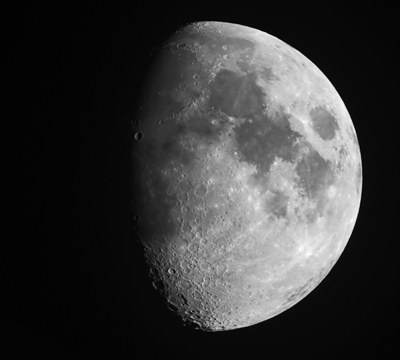
Moon 26th February 2007
Nikon D80 on Newise 200X
Image: Ian Morison
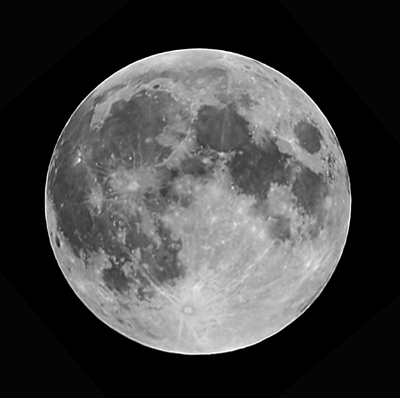
Full Moon on the night of the Total Eclipse
Nikon D80 on Newise 200X
Image: Ian Morison
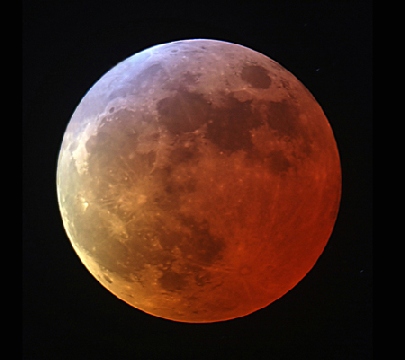
The Moon in Eclipse
Nikon D80 on Newise 200X
Image: Ian Morison
Value for Money
As the Newise X200 is unique, one cannot really compare it to anything else. However to give a feel as to how its cost compares, lets consider a Meade LX200R tube assembly. This is an f10 modified Schmidt-Cassegrain design. The basic tube costs £1099. This is less than the Newwise, but the tube assembly is totally “bare”. For Visual use it would certainly need a 2” star diagonal costing ~ £100 and a finder scope ~ £80 making the costs comparable. For many nights observing, a dewshield would be needed as well. In addition the Newise comes with two very acceptable eyepieces that are together worth about £100. Not bad value for money in my judgement.
Conclusion
As I hope the observations and images have shown, the telescope put up a very creditable performance indeed. I have telescopes that can provide very high quality planetary imaging - but do not have a wide flat field. I also have an 8” scope with an even wider field. But this is not as flat or well corrected as the Newise and the scope does not perform quite as well on planets. In contrast, the Newise is able to carry out a very wide range of observations in a highly competent way and would be an ideal telescope to take out and about to reach darker skies.
I had expected the Newise to perform well - it has had two excellent reviews in the British astronomical press - and I was not disappointed, but what endeared me most to the Newise was the ease and convenience of its use. I liked the Newtonian focus that can be positioned easily for comfortable viewing (and which enable a camara to be easily mounted ). I liked the fact that it was not too heavy and, due to its short length, easy to handle. I liked the Crayford type focuser, the right angle finder and the fact that one could collimate it whilst viewing the effects of any adjustment in the eyepiece. I liked the way the custom dew-shield was locked into position. To be honest, there wasn’t really anything that I didn’t like!
I think that this about says it all. A telescope that is easy to use is one that will be used often!
Reviewer's statement
The reviewer has no formal links with Cape Newise or its distributers but was loaned this telesope in order to evaluate it and write this review. The reviewer is Telescope Adviser for the UK Society for Popular Astronomy and co-author of two astronomy books for the Amateur. He owns and uses the following telescopes:
80mm Astronomica ED-80 Refractor
102mm Takahashi Apochromatic Refractor.
127mm Alter 500 Maksutov-Cassegrain.
150mm Helios Achromatic refractor
150mm Meade Schmidt-Newtonian
150mm Intes Micro MN-66 Maksutov-Newtonian
200mm Orion Optics, UK, Newtonian Reflector
235mm Celestron Schmidt-Cassegrain.
Jodrell Bank Home
Page | U.Man | PPARC
| MERLIN | VLBI
| Search | Feedback
